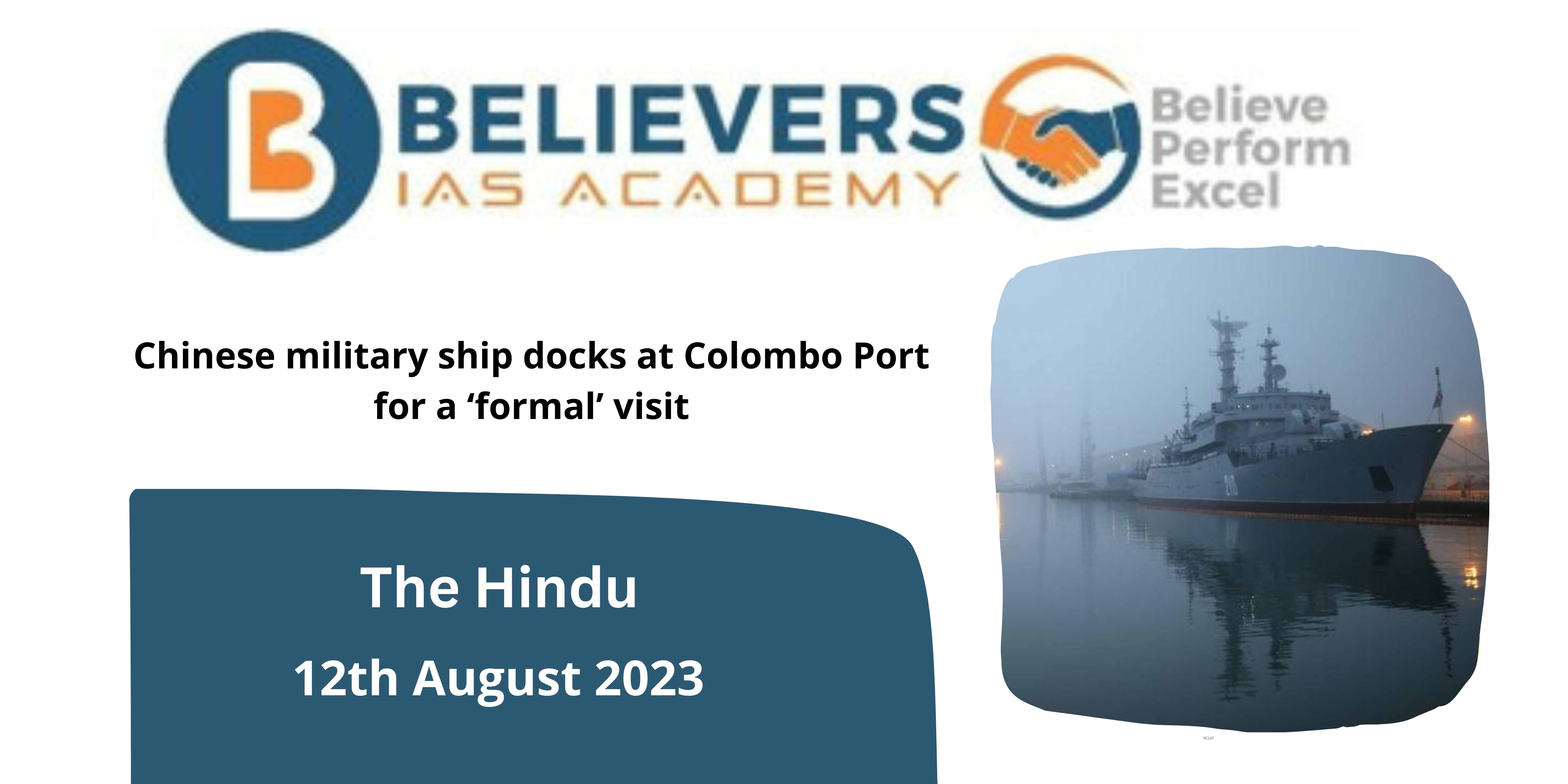Chinese Military Ship Socks at Colombo Port for a ‘Formal’ Visit
Context
The Sri Lankan Navy has announced that a Chinese warship that landed in Colombo on Thursday will be docked there till Saturday, exactly one year after the presence of a Chinese vessel led to diplomatic problems between New Delhi and Colombo.
What is the background on previous tensions?
- The Chinese satellite tracking ship Yuan Wang 5 arrived at Sri Lanka’s Hambantota Port.
- The Yuan Wang 5 is a member of China’s fleet of tracking and telemetry ships for space operations and satellite launches.
- Concerns and diplomatic tensions between India, Sri Lanka, and China arose as a result of the vessel’s arrival.
- Regarding the ship’s visit, both India and the US raised their worries.
- Despite the reservations voiced, Yuan Wang 5’s visit was not postponed.
- This incident brought to light the intricate geopolitical relationships connecting China’s expanding military power and influence in the Indian Ocean region.
- During this occasion, Sri Lanka had to manage its diplomatic relations with both China and India.

What is the recent event happened ?
- The Chinese destroyer Hai Yang 24 Hao arrived at Sri Lanka’s Colombo Port.
- The warship came in on an official visit.
- The visit lasted from Thursday through Saturday.
- The anniversary of a previous Chinese vessel’s visit, which led to diplomatic problems between India and Sri Lanka, fell on the same day as this one.
- The Chinese People’s Liberation Army Navy is home to the warship, which goes by the name Hai Yang 24 Hao.
- Sri Lankan officials made it clear that India did not formally voice any concerns regarding the visit of this vessel.
- According to Sri Lanka, the customary process for foreign vessel visits was followed and involved approval from several government agencies.
- This trip brings to light the delicate geopolitical dynamics in the area involving Sri Lanka, India, and China.
What are the problems faced by India with the Chinese presence in the Indian Ocean?
- Increased Chinese Presence in the Indian Ocean: India’s maritime interests and security may be strategically threatened by China’s growing naval presence in the Indian Ocean, particularly so near India’s coastlines.
- String of Pearls Strategy: China’s “String of Pearls” policy, which entails creating a network of friendly ports and infrastructure throughout the Indian Ocean, may cause India some concern. Chinese naval ships’ usage of Sri Lankan ports is consistent with this plan and may even improve China’s naval strength in the area.
- Naval Encirclement: It is possible to see China’s naval presence in Sri Lanka as a component of its larger ambitions to encircle India. Concerns about India’s strategic vulnerability could be increased by this.
- Influence in diplomacy: India may be concerned that China’s close economic relations with Sri Lanka may give Beijing more sway over the island nation, which may have an impact on India’s regional influence.
- Alliance Development: The visit of a Chinese warship to Sri Lanka may be interpreted as a hint that China wants to deepen its defence cooperation with Sri Lanka. A scenario where China and Sri Lanka establish deeper military ties could result from this, which might not be in India’s best interests.
- Security and Intelligence Concerns: India may be concerned about the possibility that the Chinese cruiser is gathering intelligence by keeping an eye on India’s naval operations and communication networks.
- Impact on Regional Balance: China’s military actions in Sri Lanka may have an effect on the region’s overall power dynamics, which may affect how other nations perceive their security and their strategic inclinations.
- Allies’ Reaction: India may also need to take into account how its steadfast allies and partners feel about China’s presence in Sri Lanka. India’s efforts to sustain solid ties and regional stability may be hampered by this.
- Diplomatic Pressure: If India did indeed initially oppose the warship’s visit, this could indicate India’s intention to diplomatically voice its concerns and guarantee that its interests are protected.
What is the way forward from these tense situations?
- open Communication and Transparency:
- Open channels of communication and transparency should be maintained by all parties to ensure rapid resolution of any issues or misconceptions.
- To avoid rumours and reduce the likelihood of miscommunication, Sri Lanka should keep sharing the reason for and specifics of such trips in a transparent manner.
- Diplomatic Engagement:
- To address any potential issues brought up by such visits and identify common ground, India and China should participate in diplomatic conversations.
- Sri Lanka ought to take the initiative in promoting understanding and diplomatic communication between the two countries.
- Observing Sovereignty:
- All parties should respect Sri Lanka’s sovereignty and its right to independently decide on its international relations and visits.
- China and India must respect Sri Lanka’s choices and make sure that their objectives line up with the country’s overall objectives.
- Regional Cooperation:
- To solve shared difficulties and foster confidence, all parties might strive to establish regional cooperation organizations like the Indian Ocean Rim Association (IORA).
- fostering economic ties
- The establishment of economic linkages that aid Sri Lanka’s growth, regional stability, and the wealth of Indian Ocean nations might be the main goal for all parties.
- Conflict Management:
- All parties involved should be aware of activities that could lead to misunderstandings or an escalation of tensions and take precautions to prevent any unintended disputes.




